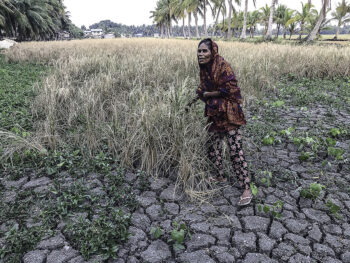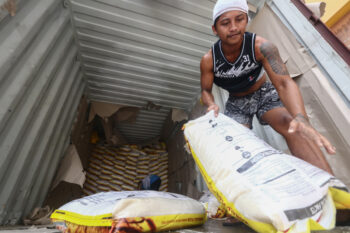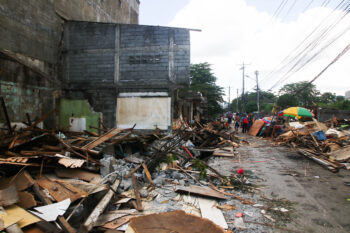NAAWAN, Misamis Oriental (MindaNews / 15 April) – While waiting for vaccine to develop, countries across the globe were faced with limited options to slow down, minimize or contain the spread of novel coronavirus, namely: social distancing, lockdown, and herd immunity.
Social distancing along with home quarantine and healthcare anti-infection protocols is the mildest of the approaches, some practices of which are incorporated in lockdown and herd immunity approach.
Lockdown got the thumbs up of many with China, the origin of the novel coronavirus, in the lead. In a lockdown, a community/village, city or the whole country is shut down. This is to prevent an infected area from infecting others outside it, and/or to protect it from infection from the outside
On the ground, serious infection is noted to spread fast and wide inside a lockdown area, compromising healthcare facilities and personnel, and incurring mounting fatalities. This is what happened in Italy, the first country to impose a nationwide lockdown.
The lockdown situation in developing countries could not be less than worse because of poverty that spells inadequate healthcare facilities, shortage of personnel, and medical supplies, and a hungry population to feed.
Only Sweden, on the other hand, appears to have approximated the herd immunity approach, with some amount of restrictions, to contain the pandemic.
The herd immunity approach is based on the theory with the underlying assumption that a community as a whole would develop a certain degree of natural protection from an infectious disease after a portion of its members actually came down with the disease, recovered from it, and became immune to it.
The more members of the herd (community) who were exposed to an infectious disease and developed natural immunity to it, the less of a threat that disease posed to the entire herd (community). The measles outbreak in Baltimore, MD, US in the 1930s was the experiential basis of the theory. It was observed that after 55% of the child population contracted measles the rest of the population appeared to be immune to the disease. The theory became the foundation of the campaign for mass vaccination worldwide later on.
UK, started apparently around the herd approach, but panicked and shifted gear when the Imperial College London came with a model that predicted 250,000 deaths if the approach is continued. The chilling forecast was enough for UK to change course. It now adopts a stay- at-home , once-a-week- getting-out limit, and social distancing policy.
As all of Europe clamps down in a move to slow down the pandemic, Sweden takes a lonesome course by shrugging off isolation. The Swedes adopt no quarantine; are free to socialize as the harsh Scandinavian winter is coming to an end. Although universities and high schools have shut, pre-schools, kindergartens, bars, restaurants, hotels, ski resorts, sports clubs and hairdressers have all remained open. There’s not much social restrictions except that those in pubs must have a seat (no standing policy) and a gathering of 50 is discouraged. Meanwhile, the elderly – 70s above, are told to self-isolate for their own protection.
Sweden Prime Minister Stefan Lofven has warned though that the times ahead would be tough but also put the onus on individual Swedes. He added: “We all, as individuals, have to take responsibility. We can’t legislate and ban everything.”
The latest world COVID-19 tally shows Sweden with infection cases of 10,483 and 899 deaths. UK, on the other hand, has 84,279 infection cases and 10,612 deaths. Italy that imposed a nationwide lockdown incurs 156,353 infection cases and 19,901 deaths. The US, which allows state autonomy in dealing with the pandemic and adopt only a nationwide policy than bans travel of its citizens and entry of foreign nationals to its territory, has an infection toll of 580,878 and 23,607 deaths, becoming now the epicenter of the pandemic. China shows amazing hard-to-believe figures – only 82,160 infection cases and 3,341 deaths, despite the fact that it was the beginning epicenter of the novel coronavirus. Nonetheless, it recently reported the possibility of second wave of widespread infection arising, accordingly, from imported transmission.
If the vaccine remains beyond grasp, there is a possibility that lockdown countries may eventually, sooner or later, give way to the herd immunity approach as a last no-other-option recourse. It would likely be sooner for developing countries, like the Philippines. The First World countries would follow suit out of exhaustion. It would be like a falling domino then.
Consider this. The lockdown situation in Metro Manila, where the great bulk of the populace is dirt poor in a-hand-to-mouth existence, is getting bleaker day by day. The lockdown shut down everybody’s capacity to earn and puts at terrifying risk the food on the table. Thus, it is unavoidable that many would dare to break lockdown protocols in efforts to stave off hunger or the fear of it. This has posed a trying challenge to enforcement. The government has now resorted to feeding a hungry population. Its capacity, however, to reach effectively and efficiently the target beneficiaries is doubtful. It is also doubtful, if it can sustain the measure however wanting for a longer duration. Because of poor enforcement, none can ascertain that the spread of viral transmission had slowed or would have been contained at the end of the lockdown period despite the extension.
Once the resources of the government are exhausted, the healthcare facilities overwhelmed by rising infection cases, the hungry populace getting larger and restless, tension may rise and violence could erupt anytime. The government would be left with no option but to lift the lockdown notwithstanding the possibility of an uncontained coronavirus spread. This could be the Plan B President Duterte is looking for.
It would be back to normal life, leaving everyone to fend himself from the virus, and acquiring, hopefully, immunity from the process.
Come to think of it. Because of the lackadaisical stance of high authorities early on and poor lockdown enforcement, COVID-19 has been with us for some 4 months now. Curiously, infection cases have remained relatively low. This is generally attributed to the inability of mass testing and the delayed results of those tested.
But, without the intention and design, would it not be possible that the Filipinos have already acquired herd immunity to the virus without their knowing? If so, lifting the lockdown would not mean much as far as the virus scare is concerned. It would, in fact, restore normalcy and sanity to all.
(MindaViews is the opinion section of MindaNews. William R. Adan, Ph.D., is retired professor and former chancellor of Mindanao State University at Naawan, Misamis Oriental, Philippines.)






